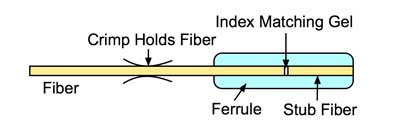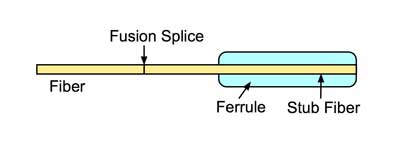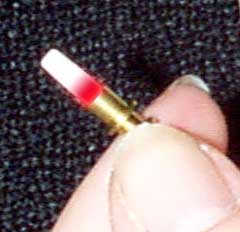The FOA Reference For Fiber Optics (original) (raw)
Alternatives To Fiber Optic Termination In The Field:
Prepolished/Splice Connectors With Mechanical Splices And Fusion Splices (SOCs)
The termination of fiber optic cable has always been considered the most difficult part of installing fiber optics. First you have to deal with hair thin strands of glass. Then you have to glue a connector on the end of the fiber and crimp it to the cable. Then, you polish the ends to get good performance.
Numerous methods for adhesive/polish connectors have been developed in attempts to simplify fiber optic termination and speed up the process. Epoxies that cured overnight were replaced by epoxies that cure in 5 minutes at higher temperatures in an oven. Quick-curing adhesives, called "anaerobics," can reduce adhesive curing time to less than 5 minutes. 3M has the "Hot Melt" connector that you heat up to melt the adhesive, insert the fiber and let it cool to set.
Companies have spent many millions developing non-adhesive connectors. Some crimp on the fiber but still require polishing. Others crimp and cleave the fiber (cleaving is the process of breaking the fiber under controlled conditions to produce a end finish in one step.) Finally, many companies have developed an option worth considering: prepolished connectors where you splice the fiber into the connector for termination.
Prepolished splice connectors eliminate the need for adhesives and polishing for field termination. They come in two varieties - a factory terminated connector with a stub fiber in the ferrule that uses a mechanical splice to terminate the fiber or a factory terminated connector with a short pigtail that is fusion spliced on the fiber being terminated. Termination only requires preparing the cable, cleaving the fiber, splicing the connector onto the fiber and adding a strain relief boot.
Prepolished/splice connector with mechanical splice
Prepolished/splice connector with fusion splice Most people refer to the connectors with mechanical splices as "prepolished/splice connectors" and the ones that use fusion splicing as "splice-on connectors" (SOCs).
Fiber optic connector manufacturers make prepolished/splice connectors by gluing a short stub fiber into the connector ferrule and polishing it perfectly with machines in the factory.
The back of the mechanical splice connector is modified with the addition of a mechanical splice, complete with index-matching gel to reduce loss at the fiber interface and a crimp to hold the fiber. Terminating these connectors is super-simple: cleave the fiber, insert it into the connector, crimp it in place and you are finished. No adhesive, no polish. Terminate a fiber in less than one minute.
SOCs have a short pigtail on the back of the connector ready to be cleaved with the fusion splicer cleaver and fusion spliced on to a fiber. The time for this termination is no longer than the time to make a fusion splice.
A misconception concerns connectors that are installed by splicing on the end of a fiber, wither by mechanical or fusion splicing, or by splicing on a pigtail. The connection loss of this type of termination includes the typical connection loss tested when mated to a reference connector plus the splice used to attach the connector to the fiber, as the splice is the attachment method and therefore included in the connection loss. This is how standards often list high losses for connectors because they must include not only the direct attach adhesive/polish connectors but also splice-on connectors and array connectors with many fibers. SOCs - Fusion Splice-On Connectors Splice-on connectors are a relatively new development that has been seeing greater acceptance with installers. of the SOC. It's popularity started in data centers for singlemode fiber where the number of connections is very large so the cost of a fusion splicer is readily amortized and the speed of making connections is the real cost advantage. The cost of fusion splicers has been dropping to near the cost of a prepolished/splice (mechanical splice) connector kit so the financial decision to use SOCs is easier to make. The performance of SOCs is much better than prepolished/splice (mechanical splice) connectors simply because of the superiority of a fusion splice over a mechanical splice and the cost of the SOCs are much less since they do not have the complex mechanical splice in the connector.
SOC installation process with the EasySplicer.Termination with a SOC is simple. The fiber to be terminated is prepared as usual: strip, clean, cleave and insert in the splicer. The connector is placed in a special holder that positions it in the cleaver to cleave the fiber at the proper length. The holder is inserted in the splicer, the program is run to make the splice and a heat shrink protector completes the process.
Detailed process description for the EasySplicer SOC installation.
Connectors With Mechanical Splices
Prepolished splice connectors are very fast terminations but are not without their downsides. Since there is a mechanical splice and a connector, the total loss includes one connector plus a splice loss. Since the splice loss is dependent on the quality of the fiber cleave, it requires a very precise cleave from a top quality cleaver. Since the fiber is not attached with adhesive, the attachment strength depends on a good crimp. The latest generation kits solve most of those problems so prepolished/splice connectors can now provide a very fast termination with satisfactory loss if a few precautions are followed.
Corning Unicam Pretium termination process includes verification of proper spliceThe economics of prepolished splice connectors is based on the lower time needed for each termination. The manufacturing process makes each connector more expensive and the good kits with quality cleavers are more expensive than adhesive/polish termination kits, even those with epoxy curing ovens. However, the lower cost of labor can make these connectors cost effective, especially when only a few connectors are being used. The secret to lowering costs is getting high yield of good connectors and that depends on having the right tools and training - and practice.
These connectors will never have loss as low as an adhesive connector, since they are actually an adhesive/polish connector with a mechanical splice inside them so you have both a connector loss and a spice loss. The good news is the connector factory polish is first class, so the connector to connector interface has low loss, probably averaging better than 0.2 dB loss. The bad news is the splice can add 0.3-0.5 dB to the total loss of the termination, making them a 0.5-0.7 dB connector at best.
Techs now achieve around 0.5 dB loss from these connectors, using an quality cleaver typically used with fusion splicers. This cleaver produces consistent, high quality cleaves to mate with the fiber stub in the connector. The fiber must be inserted into the connector and kept under tension during the crimp process, to make sure the two fiber ends in the internal splice stay in contact. Using these techniques, techs have been getting excellent yield of connectors that better the TIA-568 standard requirement of 0.75 dB loss or less. Some manufacturers of prepolished/splice connectors acknowledge these issues, and they now offer termination kits with precision cleavers and tools that carefully hold the fiber and connector during the termination process.
Another trick in using these connectors is to visually confirm the quality of the splice you make in terminating them, an automatic feature of newer termination kits. A visual fault locator (VFL) with a bright red laser can be used to optimize the internal splice. The light lost in the splice is visible through the body of the connector, so one can confirm the splice is good when the red light is minimized. Adding a VFL to your toolkit along with a precision cleaver is another necessity.
It�s mandatory to get good training on the termination process for these connectors, even if you are already familiar with adhesive/polish connectors. Most manufacturers� termination kits include special tools for holding and crimping the connector, as well as that inexpensive cleaver that we recommend you replace by a really good one. It is absolutely mandatory to get trained on the use of these tools and the exact process recommended for termination. And, of course, you should practice enough with these connectors to become proficient in their use before bidding or using them on a job.
The economics of these connectors depends heavily on the yield of good connectors during installation. When a prepolished connector costs considerably more than an adhesive connector, it is critical to make sure every connector installed is a good one. That�s why a quality cleaver, a VFL and a couple of days training is a worthwhile investment. Only when an installer can equal the yield of adhesive/polish connectors can a direct comparison of installed costs be made. Then the advantages of these connectors fast termination times can be fully exploited to save labor costs in any project.
Unicam termination photo courtesy Corning Cabling Systems.
Virtual Hands-On Instructions For Prepolished/Splice Connectors.





